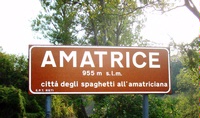WINE WITH…Pasta all’ Amatriciana
“Amatrice is not here anymore. Half the town is destroyed.” This chilling announcement by Amatrice’s mayor, Sergio Pirozzi, was the first thing many of us heard when we woke up on August 24. The earthquake, which destroyed the town and damaged so many other communities in Italy’s midsection, killed more than 300 people and left scores wounded. One of the sad ironies of the disaster is that Amatrice

was in full-swing of preparations for its celebration of the fiftieth anniversary of a festival honoring pasta all’ Amatriciana, the region’s signature dish.
In the aftermath of the disaster Italian restaurateurs and chefs did what comes naturally to them: they cooked, and many of them donated a portion of every order of pasta all’ Amatriciana to a variety of organizations that support relief and rebuilding operations. The #Amatriciana campaign went viral immediately, directing customers to restaurants that support the relief efforts. Cooks and restaurateurs from as far away as London, Los Angeles and New York are also encouraging customers to order the iconic Italian dish and are donating a portion of the profits to relief organizations. (For example, the Manhattan restaurant Felidia has listed the dish on its menu as “Un’ Amatriciana per Amatrice.” Priced at $30, five dollars of every order will be donated to the Italian Red Cross relief effort for the next year.)
As with any regional dish whose history is flavored by myth and time the exact recipe for pasta all’ Amatriciana is somewhat open to debate. Originally a simple pasta preparation made by shepherds in the mountains, its ingredients included little more than dried pasta flavored with guanciale (salted, cured pork cheek), lard, red pepper flakes, salt, and local Pecorino cheese. Tomatoes arrived later, but are now essential to the dish. While contemporary recipes include garlic and onion, traditionalists frown on those additions. In testing various recipes, we found that we preferred the more minimalist approach. Of course we love garlic and onion, but their addition makes this just another good tomato sauce–there’s nothing wrong with it, and for that matter plenty right with it, so go ahead and add garlic and onion if you must, but you’ll be missing the purity and freshness of the authentic recipe.
And speaking of authentic ingredients, while guanciale is becoming easier to find in US markets it still remains elusive in most places. Pancetta is frowned upon by purists, but we used it and found it a mighty tasty substitute. Likewise, we substitute olive oil for the classic lard, but if you have lard on hand by all means use it. Regular spaghetti is delicious, but bucatini, long, thin, tubular pasta, is denser and perhaps even tastier. Right now we prefer to use the fresh, juicy tomatoes that are available at the local farmers’ market, but we’ll revert back to canned when the season ends.
Pasta all’ Amatriciana
Serves 4-6
1 tablespoon olive oil
4 ounces pancetta, diced
½ teaspoon red pepper flakes
4 cups of peeled*, chopped fresh tomatoes (or 500 grams of canned, peeled tomatoes)
½ cup white wine
½ teaspoon salt
2 pounds spaghetti or bucatini pasta
100 grams of grated pecorino cheese plus extra cheese to pass at the table
Heat the oil in a large skillet, then add the pancetta. Add the pepper flakes and cook, stirring frequently, until the pancetta is light browned and starting to crisp up, then remove it to a bowl. Add the tomatoes to the skillet and cook them for about 10 minutes. Add the wine and salt, and simmer for 20-30 minutes, or until the tomatoes have cooked down and are very soft and tender. Stir the pancetta in and simmer the mixture for another five minutes or so.
Bring a large pot of salted water to a boil and add the pasta. Cook according to package directions. Drain the pasta then return it to the pot. Stir in ¾ of the tomato sauce and all the Pecorino cheese. Pour the mixture into a serving bowl (or individual bowls) and top with the remaining sauce. Serve at once,
*To peel fresh tomatoes drop them into boiling water then immediately remove them; the skins should slip right off.
* * *
Because Pasta all’ Amatriciana hails from a rural and traditionally somewhat impoverished part of Italy, we chose mostly value-priced wines to sample with it. We did open a couple of bottles with price tags over $25, one of which showed very well, but otherwise we focused on wines costing under $15. A number of them, reds as well as whites, performed admirably. The reds gave the wine added depth, while the whites provided lift and liveliness. We enjoyed both, as our recommendations make clear.
 was in full-swing of preparations for its celebration of the fiftieth anniversary of a festival honoring pasta all’ Amatriciana, the region’s signature dish.
was in full-swing of preparations for its celebration of the fiftieth anniversary of a festival honoring pasta all’ Amatriciana, the region’s signature dish. 